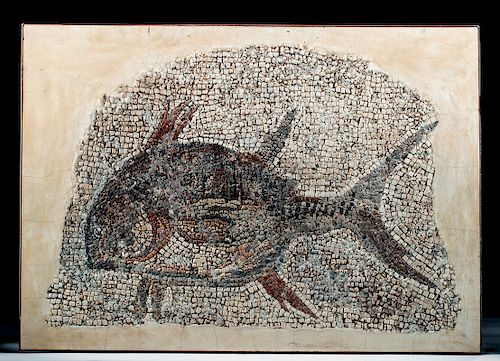Superb Roman Stone Mosaic of a Large Fish
Lot 60
About Seller
Artemis Gallery
686 S Taylor Ave, Ste 106
Louisville, CO 80027
United States
Selling antiquities, ancient and ethnographic art online since 1993, Artemis Gallery specializes in Classical Antiquities (Egyptian, Greek, Roman, Near Eastern), Asian, Pre-Columbian, African / Tribal / Oceanographic art. Our extensive inventory includes pottery, stone, metal, wood, glass and textil...Read more
Categories
Estimate:
$18,000 - $25,000
Absentee vs Live bid
Two ways to bid:
- Leave a max absentee bid and the platform will bid on your behalf up to your maximum bid during the live auction.
- Bid live during the auction and your bids will be submitted real-time to the auctioneer.
Bid Increments
| Price | Bid Increment |
|---|---|
| $0 | $25 |
| $300 | $50 |
| $1,000 | $100 |
| $2,000 | $250 |
| $5,000 | $500 |
| $10,000 | $1,000 |
| $20,000 | $2,500 |
| $50,000 | $5,000 |
| $100,000 | $10,000 |
| $200,000 | $20,000 |
About Auction
By Artemis Gallery
Feb 13, 2020
Set Reminder
2020-02-13 10:00:00
2020-02-13 10:00:00
America/New_York
Bidsquare
Bidsquare : Exceptional Antiquities, Asian, Ethnographic
https://www.bidsquare.com/auctions/artemis-gallery/exceptional-antiquities-asian-ethnographic-4848
An important one-day auction featuring museum-worthy examples of Egyptian, Greek, Roman, Etruscan, Near Eastern, Far East / Asian, Pre-Columbian, African / Tribal, Oceanic, Native American, Spanish Colonial, Russian, Fossils, Ancient Jewelry, Fine Art, so much more! Artemis Gallery info@artemisgallery.com
An important one-day auction featuring museum-worthy examples of Egyptian, Greek, Roman, Etruscan, Near Eastern, Far East / Asian, Pre-Columbian, African / Tribal, Oceanic, Native American, Spanish Colonial, Russian, Fossils, Ancient Jewelry, Fine Art, so much more! Artemis Gallery info@artemisgallery.com
- Lot Description
Roman, the Levant, late Imperial Period, ca. 200 to 300 CE. An impressive mosaic comprised of square and triangular stone tesserae depicting an aquatic scene featuring a large fish swimming toward the left. The fish is beautifully modeled in an attractive color scheme of salmon pink, tawny beige, sienna, umber, yellow ochre, white, dove grey, charcoal, and black against a creamy white ground so as to provide a sense of three dimensionality and motion as well as anatomical details. The artist skillfully used these different colors and shapes to shade and model the form - approximating three dimensions as well as a sense of movement. Size: 29.5" W x 20.5" H (74.9 cm x 52.1 cm); 33" W x 24" H (83.8 cm x 61 cm) including the matrix and frame
Mosaics (opus tesellatum) are some of our most enduring images from the Roman world, exciting not only for their aesthetic beauty, but also because they reveal what Romans chose to depict and see decorating their private and public spaces. Aquatic and maritime subjects were popular in Greco-Roman art. One of our favorites is in the House of the Faun in Pompeii (end of 2nd century BCE, Museo Archeologico Nazionale, Naples). Another from Piazza Armerina, room 22, depicts an entertaining scene of winged Erotes reeling in their catch (4th century CE).
Provenance: private Dere collection, New Jersey, acquired between 1980 and 1990
All items legal to buy/sell under U.S. Statute covering cultural patrimony Code 2600, CHAPTER 14, and are guaranteed to be as described or your money back.
A Certificate of Authenticity will accompany all winning bids.
We ship worldwide and handle all shipping in-house for your convenience.
#151796Some nicks/chips to tesserae and areas of loss as shown - mostly to the perimeter but also to some areas of the interior composition as shown. Set in a pigmented concrete matrix with a metal frame for support. Some pressure fissures and stabilization to the matrix.Condition
- Shipping Info
-
All shipping is handled in-house for your convenience. Your invoice from Artemis Gallery will include shipping calculation instructions. If in doubt, please inquire BEFORE bidding for estimated shipping costs for individual items.
-
- Buyer's Premium



 EUR
EUR CAD
CAD AUD
AUD GBP
GBP MXN
MXN HKD
HKD CNY
CNY MYR
MYR SEK
SEK SGD
SGD CHF
CHF THB
THB














